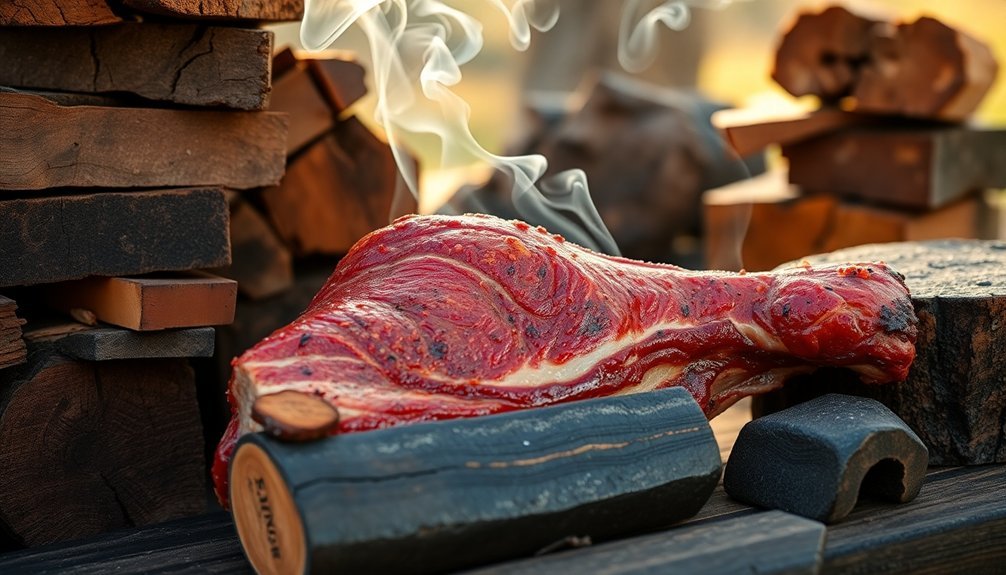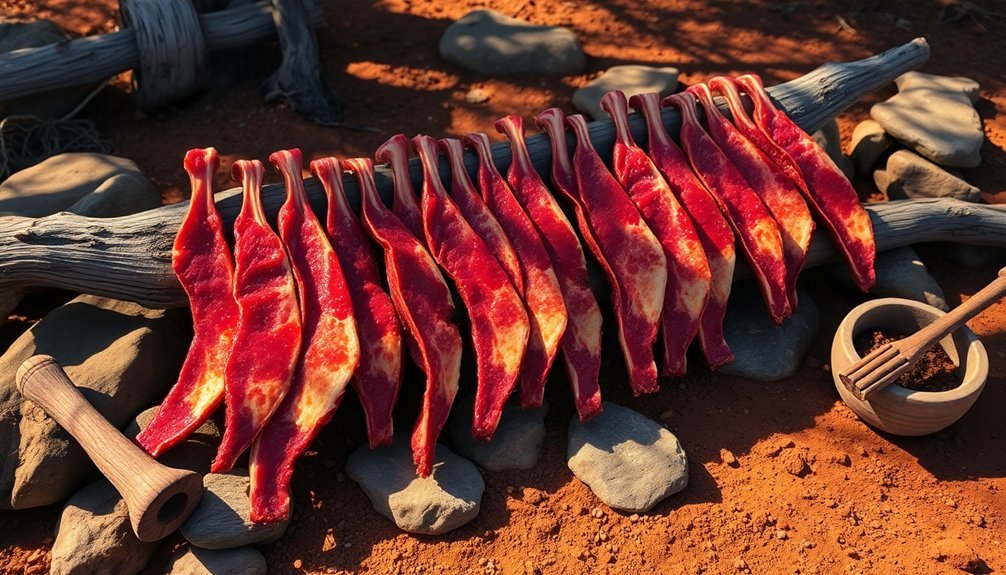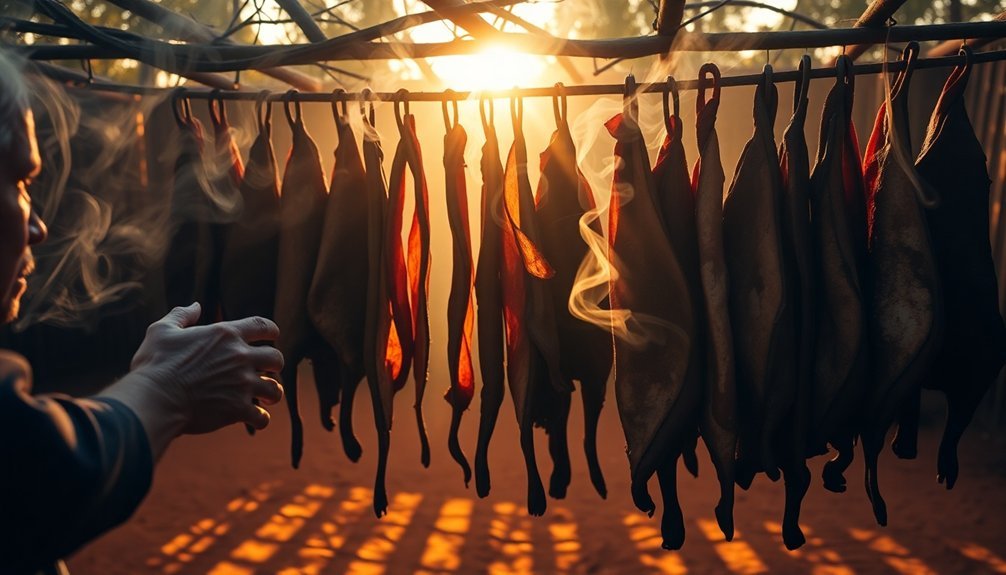Aboriginal meat smoking techniques, perfected over 65,000 years, will transform your smoking game. You'll need to start with the right wood – hardwoods like oak and fruit woods for specific meats, never pine or cedar. Master traditional fire-building methods such as the hand drill or fire plough to create the perfect ember base. Prepare your meat by cutting uniform strips and removing excess fat, then season generously. Keep temperatures between 150°F and 225°F for ideal results, and remember that patience isn't just a virtue – it's crucial to the sacred smoking process. These ancient secrets hold the key to smoke-perfection.
Choose The Right Wood

When smoking meat like our Aboriginal ancestors, selecting the right wood is essential to achieving authentic flavors. You'll want to focus on hardwoods like oak, hickory, and maple, which provide consistent, high-quality smoke.
Fruit woods such as apple and cherry offer a milder, sweeter profile that's perfect for pork and game birds. Soaking wood chips for about 30 minutes helps prevent unwanted flare-ups during smoking.
Stay away from coniferous woods like pine and cedar, as they'll produce unpleasant flavors and can even be harmful. Similarly, don't use walnut, which creates an overpowering bitter taste.
Instead, opt for versatile oak when smoking brisket or wild game, or choose hickory for ribs and pulled pork. If you're smoking fish or turkey, you'll find alder and beech woods provide ideal results.
Before using any wood, verify it's properly kiln-dried and bark-free. Don't fall for the myth about soaking wood – it only reduces flavor and extends smoking time.
Source your wood from reputable suppliers or, if harvesting yourself, use a hand saw and properly season the wood in a dry place. Most importantly, ascertain your wood hasn't been treated with chemicals or oils that could contaminate your food.
Traditional Fire Building Method
Throughout Aboriginal Australia, several ingenious fire-starting methods have been perfected over thousands of years.
If you're in northern or coastal regions, you'll want to try the hand drill method, where you'll create friction between two sticks until you produce a glowing ember in the powdery sawdust. You'll need to blow gently on the ember and transfer it to your tinder. This ancient technique has been preserved through generations as traditional knowledge holders pass down these vital skills.
In inland areas, you can use the fire saw and cleft stick method. Split one stick and wedge it apart, then rub another stick or even a boomerang across it until an ember falls through the gap. You'll find macerated spinifex makes excellent tinder for this technique.
If you're in Central Australia, try rubbing the edge of a spearthrower over a soft shield – it's an effective variation of the fire saw method.
In South Australia, where flint is available, you can use the percussion method by striking flint against pyrites to create sparks.
There's also the fire plough method, introduced in the 1800s, which you'll find useful in the Broome and Ninety Mile Beach area by rubbing one piece of wood along another's groove.
Preparing Your Meat

With your fire ready to go, proper meat preparation becomes your next priority. Start by thoroughly cleaning your wild game or fish, removing any dirt, blood, or debris. Rinse the meat under cold water and pat it dry with clean cloth or paper towels. Double-check for any remaining contaminants before moving forward.
You'll want to slice the meat into thin, uniform strips about 1/8 inch thick, cutting along the natural grain for best texture. Following traditional methods, you can begin by cutting each chuck down the middle. Make your cuts long enough to hang easily in your smoke shack. As you cut, remove as much fat as possible, along with any sinew, gristle, or connective tissue. Don't waste the fat though – you can render it separately as a valuable calorie source.
Before smoking, you'll need to season your meat thoroughly. Apply your chosen dry rub or marinade generously, making sure you've covered all surfaces evenly.
Let the meat rest for at least an hour in the refrigerator – this waiting period allows the seasonings to penetrate deeply into the meat, ensuring better flavor distribution throughout the smoking process.
Smoke Temperature Control
According to ancient Aboriginal smoking practices, maintaining precise temperature control stands as the most critical factor in producing high-quality smoked meats. You'll want to keep temperatures between 150°F and 225°F for ideal results. To test this without a thermometer, hold your hand near the meat – if you can keep it there for 8-10 seconds, you're in the right range.
For the best results, maintain a low, smoldering fire that doesn't directly touch the meat. You'll need to monitor and adjust your fire regularly, adding hardwood as needed to maintain consistent temperatures and smoke levels.
| Temperature Range | Smoking Method | Duration | Best For |
|---|---|---|---|
| 68°F – 86°F | Cold Smoking | Varies | Preservation |
| 126°F – 180°F | Hot Smoking | 4-6 hours | Thin Cuts |
| 150°F – 225°F | Traditional | 6-12 hours | Medium Cuts |
| 225°F+ | Avoid | N/A | Not Recommended |
Remember that high temperatures can break down flavor molecules into unpleasant compounds. When adding cold meat to your smoker, don't adjust the fire immediately – the chamber will naturally return to the set point as the meat warms up.
Sacred Timing and Patience

Traditional smoking practices place deep significance on timing and patience, extending far beyond basic temperature control. You'll find that Aboriginal approaches to smoking emphasize the importance of waiting for the right moment, much like their cultural understanding that certain activities require sacred timing.
You need to recognize that smoking meat isn't just about the technical process – it's about creating an environment of calm and purpose. Just as Aboriginal communities use smoking as a social bonding activity, your smoking process should be unhurried and intentional.
You'll achieve better results when you avoid rushing and instead focus on the meditative aspects of the process. When you're smoking meat, treat it as a cultural practice rather than just a cooking method.
Replace any urge to rush with meaningful activities around the smoking area, similar to how Aboriginal communities build relationships during shared activities. You'll want to maintain your focus while allowing the process to unfold naturally.
The most successful outcomes occur when you respect the timing of each stage, letting the smoke work its magic without interference, much like traditional practices that honor patience as an essential ingredient.
Frequently Asked Questions
How Do Traditional Smoking Ceremonies Differ From Meat Smoking Practices?
You'll find traditional smoking ceremonies focus on spiritual cleansing and healing using native plants for sacred rituals, while meat smoking is purely a food preparation method using wood smoke for flavor and preservation.
What Alternative Meats Were Commonly Smoked Besides Kangaroo and Possum?
You'll find that bison, elk, and moose were commonly smoked by Indigenous peoples. They'd also smoke wallaby meat, though it wasn't as widespread. These meats were chosen for their availability and nutritional benefits.
Did Coastal Aboriginal Groups Use Different Smoking Techniques Than Inland Communities?
You'll notice coastal Aboriginal groups mainly used Macassan-influenced smoking methods with long pipes made from crab claws and reeds, while inland communities stuck to traditional practices like pituri chewing and bush tobacco use.
How Did Seasonal Changes Affect Traditional Meat Smoking Methods?
You'll find that seasonal changes affected smoking methods through available wood types, adjustments to smoking duration in wet weather, and the need to preserve more meat during abundant hunting periods for leaner times ahead.
Were Specific Tools or Containers Traditionally Used for Collecting Smoke-Flavored Drippings?
You'll find that traditional smokers used bark containers, clay pots, or hollowed logs placed beneath the meat racks to catch valuable drippings. These natural vessels preserved the flavorful juices for later use.
In Summary
You've now learned five ancient aboriginal techniques that'll transform your smoked meats into something truly special. By selecting proper wood, building fire traditionally, preparing meat correctly, controlling temperature precisely, and embracing patient timing, you'll honor these time-tested methods. Don't rush the process – remember that smoking meat isn't just cooking, it's a sacred practice that's been perfected over thousands of years.





Leave a Reply